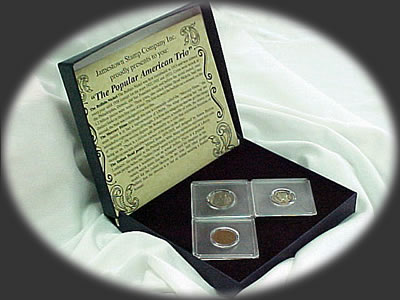|
The Buffalo Nickel, The Mercury Dime and The Indian Head Penny Hold onto your hats for this one. Sometimes we even amaze ourselves. Three Popular U.S. Coins in an attractive box and saftey enclosures for only $9.95. The Buffalo Nickel was first introduced in 1913 and was minted every year until 1938 (except for the years 1922, 1932 and 1933). Coins were struck at the Philadelphia, Denver, and San Francisco mints and before the series ended over 1.2 billion pieces were made. These coins, also called Indian Head Nickels, had two distinct looks in their first year of issue. The first showed the buffalo on a mound; on the second, the base was redesigned to a thin line. Designed by James Earl Frasier, the Buffalo Nickel is the only coin to picture an animal, besides the eagle, as it’s main focus. The Indian on the front was modeled after 3 different Indians. The Buffalo was modeled after “Black Diamond” in the New York Zoological Gardens. The Mercury Dime Although this coin is commonly called the “Mercury Dime,” the main device is in fact a representation of Liberty. The wings crowing her cap are intended to represent liberty of thought. It is from the winged cap that we get the image of “Mercury”. The reverse depicts the Roman fasces, a bundle of rods, the center rod being an ax. As a symbol of state authority, the fasces offers a choice: “by the rod or by the ax”. There is a curious split personality to a coin that celebrates Freedom of Thought on one side and the absolute power of the state on the other. The designer was Adolph A. Weinman, who also designed the Walking Liberty Half. The Indian Head Penny Minted from 1859-1909, this coin was designed by James Barton Lonhacre, the engraver at the Philadelphia Mint. Many mysteries surround this coin. Some people believe the “Indian Head” penny is in fact a representation of Liberty wearing a headdress, not an actual Indian. There is a popular rumor, which states that Mr. Longacre used his daughter as his model for the Indian likeness on the cent. And other people believe that the obverse is in fact an Indian wearing a feather bonnet. The coin’s reverse side shows One Cent within a laurel wreath. In 1860 the reverse design was changed slightly, showing One Cent within an oak wreath, with three arrows inserted under the ribbon that binds the two branches of the wreath. It is probably the most famous of all the U.S. coins. It was produced for 50 years without hardly a change in its design. Denomination: 1 cent, 1 nickel, 1 dime Year: various
Price: $9.95
| |

